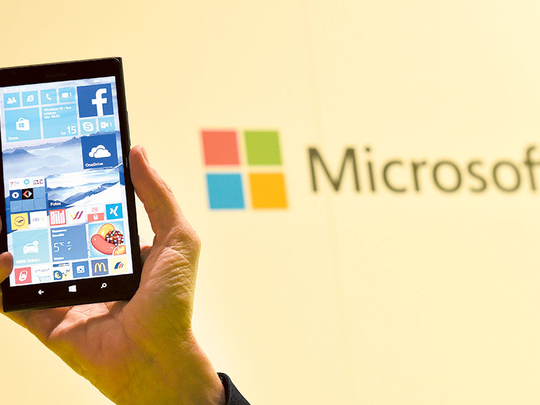
Dubai: Windows mobile division will continue to struggle over the next few years and the new OS — Windows 10 Mobile — will not greatly impact Microsoft’s ailing smartphone business, industry experts told Gulf News.
The mobile OS will be launched by end of the year.
“There may be an increase as it launches new flagship products for the first time in over a year. While Microsoft has made some progress selling low-end, cheaper smartphones such as the Lumia 530, it will need to gain some traction in the high-end of the market to attract developers to the platform,” said Daniel Gleeson, mobile analyst at IHS Electronics & Media.
Microsoft announced several new Windows Mobile partners over the past two years, but very few actual handsets came from those announcements.
Microsoft is now the only manufacturer producing Windows handsets in any significant volume as both HTC and Samsung appear to have abandoned the platform.
Ian Fogg, head of mobile analysis at IHS Technology, said that Windows 10 Mobile is “one step forward and two steps back” for Microsoft. Microsoft is again trying to make its mobile OS a mimic of its large screen PC OS as it used to do before the grand Windows Phone relaunch in 2010 in response to the iPhone and Android.
“Microsoft has lost the smartphone OS war to iOS and Android. Now, Microsoft is pursuing a strategy clearly inspired by that understanding. It is prioritising the PC version of Windows 10 for delivery first, not mobile. And, Microsoft is offering its flagship apps such as Microsoft Office and Halo for the rival smartphone OS, which have the bulk of the users,” he said.
And, just as in the past, he said that Microsoft again risks a lowest common denominator experience with the smartphone weakened as a result of not being fully optimised for the phone. Also, many of the trademark user interface decisions which differentiated the modern user interface on smartphones have been withdrawn in this new version.
Microsoft failed to gain traction and finally lost ground to Apple and Google.
The purchase of Nokia two years ago did not materialise and the company took a $7.5 billion (Dh27.55 billion) write-down in its latest quarterly earnings report.
Saad Elkhadem, research analyst for systems and infrastructure solutions at International Data Corporation, said that a major factor for this lack of growth and traction is the Windows Phone eco system, which just hasn’t truly managed to gauge the backings of developers, which in this day and age is essential if an OS is going to stand any chance of survival.
“It will take some time for the channel, consumers, and developers to get on-board to really see the true potential of this new OS,” he said.
For the MEA region, IDC does see that Windows 10 will have a positive impact and expects Windows Phone in total to grow to over 3.8 per cent by the end of 2016, a rather small piece of the pie in the face of the ongoing competition.
“This will not be an overnight success, instead, it’ll be a slow and steady battle but Microsoft has the power and force to keep it fighting,” Elkhadem said.
With Microsoft intent on cutting costs from the loss making handset business, Gleeson said that it is difficult to see how the business will have the strength to grow significantly without convincing several additional manufacturers to produce Windows smartphones.
IHS forecasts that Windows Mobile market share will remain close to 4 per cent of the overall smartphone market for the next few years (once Windows 10 gains some momentum).
Given Windows’ poor performance in the market, he said that manufacturers will need proof it can succeed before devoting resources to it. This leaves Microsoft in a “catch-22 situation”.











